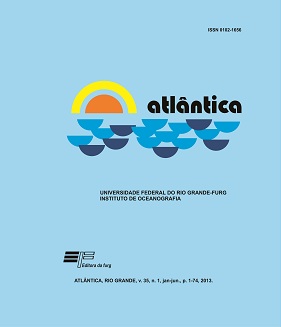EXPORT AND RETENTION OF DECAPOD LARVAE (CRUSTACEA) IN MACAÉ RIVER ESTUARY (RJ) (22º22’S-041º46’W).
DOI:
https://doi.org/10.5088/atl.2013.35.1.23Keywords:
Decapoda, Exportação larval, Sudeste do BrasilAbstract
Estuarine or freshwater decapods which have indirect development and hatch near the estuary show strategies to avoid or to resist environmental stress. There are two well known patterns of larval development of estuarine populations: export strategy and retention strategy. Therefore, this study aims to characterize the spatial-temporal variations among the planktonic decapods in the estuary of Macaé river, southwest Brazil, and identify taxa with the mechanism of larval retention or export. Samples were collected in July 2001 and February 2002, during six consecutive tidal cycles. Horizontal samplings (about 0.5 m and 1.5 m depth) were done simultaneously. Statistical analysis was performed to test the effects of tide, daylight, depth and local of sampling upon density of taxa. Twenty four taxa were identified among larvae, post-larvae, juveniles and adult forms (Lucifer faxoni only). Tidal variation and light intensity were the most relevant environmental factors affecting decapod distributions. The present results showed three distinct groups during the sampling periods: I. Larvae associated with nocturnal ebb tides (larval exportation); II. Larvae associated with flood tide (larval retention) and III. Megalopa, decapodid and juveniles related to the samples taken during nocturnal flood tides near the bottom (returning to the estuary).Downloads
Downloads
Published
2014-11-28
How to Cite
Almeida, E. V. de, Bonecker, S. L. da C., & Fernandes, L. D. de A. (2014). EXPORT AND RETENTION OF DECAPOD LARVAE (CRUSTACEA) IN MACAÉ RIVER ESTUARY (RJ) (22º22’S-041º46’W). Atlântica (Rio Grande), 35(1), 23–34. https://doi.org/10.5088/atl.2013.35.1.23
Issue
Section
Artigos


